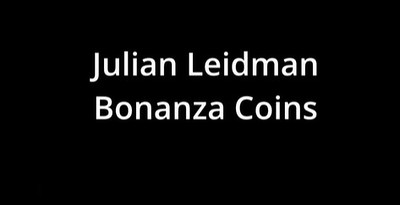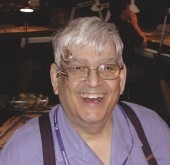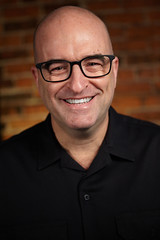
PREV ARTICLE
NEXT ARTICLE
FULL ISSUE
PREV FULL ISSUE
JULIAN LEIDMAN INTERVIEW, PART TWOGreg Bennick's latest interview for the Newman Numismatic Portal is with dealer Julian Leidman. Here's the second part, where Julian talks about some favorite coins and the Wilkison collection. -Editor
That was Steve Rudell, who was a local dealer here, but he and a national following, and he was interested primarily in silver dollars. I know, at times, promoting the ‘93-S and the ‘94 P. But he was also interested in patterns, and that's where my interest in that came. But anyhow, Armand showed me this book, and in this book were all the gold patterns, pictures of them. And I said, ‘Wow.' And he told me a little bit about it. He said he had met the owner of the collection, and had these pictures. And I said, ‘Wow, that's absolutely incredible.' And so, fast-forward to 1973 in Boston, I'm on the bourse floor at the ANA convention, and I'm walking down the aisle, and I see the same book in a dealer's case. And I said, whoa. So, I asked what the deal was, and they said, well, Dr. Wilkison had retained them to market the collection. So, I said, ‘Hmm,' and I went and talked with another one of my long-time colleagues, Mike Brownley from Dallas, and I told him about this. And we went back over to the dealer that had it. It was the Tennessee Exchange. Tennessee Exchange was four numismatists that had gotten together and formed a company. And of course, they knew Dr. Wilkison. Dr. Wilkison was in Springfield, Tennessee, and they were in Nashville, which is about an hour away. So, I had a little bit of experience in Nashville. I had experimental surgery done at Vanderbilt University in 1971, so I had met Tennessee Exchange there, and I had met them at coin shows. They were very active. Let me see - Ty Buckston, Gentry Hale, John Powers... I just can't remember the fourth right now. They were all very nice people. So, Mike and I made arrangements to go to Tennessee after the ANA. And we went to Tennessee, we met up with three of them, I think. Pete- Pete was the fourth guy's name, I just can't remember his last name. But either two or three of them took Mike and I to Springfield, and we met Dr. Wilkison, who was a surgeon in Springfield, Tennessee. And it was very enjoyable. He took us and showed us the collection... And I'm overwhelmed again. Here they are in front of me. And I say, ‘Wow, this is absolutely incredible.' So, we talked a little bit, and we asked if we could market it for him, and he said yes for a month. You can do that. So, we then went to a nice lunch at his favorite restaurant, which is a little diner in Springfield. Not a diner, but a small restaurant that he probably went to every day. And we had a nice lunch there, and we left. Now, Mike was officing at the time with Harry W. Bass Jr., and Harry was an advanced numismatist, collecting gold coins by die varieties, and US patterns. Harry was also wealthy. And we said, well, this is the perfect place. Now, this collection had a few duplicates in it, so we decided, well we'd be happy to just take the duplicates as our commission, and we approached Harry with it. Mike really approached him, because he saw him every day. And Harry said he'd been offered the collection previously, I think by John Ford, and he just couldn't bring himself to spending... What we were gonna have to get was $750,000 net. So, Harry said he just didn't think the value was there. We really felt he was making a mistake, but that was that. I mean, it was his money, his collection. And I had been doing business with Harry for several years, and of course, Mike was now officing with him, so we stepped back a few feet and we said, well, we'll go to some of our own clients. And so, pattern collectors, over the years, have been very enthusiastic numismatists. So, I had a couple of very good people that I've been working with. One was Rogers M. Fred Jr. Rogers was in Washington DC, he was in business with his father in a coffee company, Browning and Baines. I met him through a dealer I was working with in 1965, Larry Camp and Jim Studley at Washington Rare Coins. And I met him at his office there. But fast-forward to 1973, I called Rogers up, and I said, ‘Rogers, we've got an incredible opportunity here. I know what you've collected in coins, I know what you've enjoyed your patterns with. This is gonna be a spectacular addition.' Rogers was well-off. They had money. But, he just said it was too much money for him to consider. I said we'll take the duplicates as a commission, and he just said it wasn't gonna work. And then, I went to Rudy Sieck out in Iowa. Rudy was also a very enthusiastic collector, and he was a farmer. He was well-off, but he said the same thing. He just couldn't spend that much money on the collection. So, step back a few feet again... I don't think I offered it to anybody else myself, but Mike called up Max Humbert at Paramount International, and said, ‘Max, what do you think?' And Max said, ‘I'd like to have an opportunity to do something with this. Let's go look at it.' So, Max and David Akers from Paramount met us in... Excuse me just a second. Greg Bennick: Sure. Julian Leidman: Met us in Nashville again. And we went up to Springfield, and met with Dr. Wilkison. I'm not sure if one of the partners at Tennessee Exchange was with us or not, because they had an arrangement with Dr. Wilkison where they were gonna get a commission as well. So, we explained it to Max. ‘Listen, Max, you can either buy this outright, and we'll take a few duplicates as our commission, or you can pass the 10% commission.' And they - mostly Max, because Max was the president - decided that that's what they were going to do. And they made a deal with Dr. Wilkison, I think, that they would pay him within a month or something like that, and Paramount was gonna pay us our commission separately. And as it turned out, they gave us each five percent that we could take in trade from Paramount directly, or in their auctions. So, that was fine, we were happy with that. And they took possession of the collection. This was... It had to be still in 1973, yeah. And they took it back to Ohio, and David worked on a catalog, he produced a spectacular catalog of all the coins in the collection, and went forward with it. I think in 1975, they traded A-Mark in California, the entire collection, for Redfield Dollars. Steve Markoff, who was A-Mark, had purchased the Redfield hoard of dollars, and they traded the collection for Redfield Dollars. And then, Paramount went on to market the Redfield Dollars over the years. And now, Steve had this collection of patterns. I don't know that he necessarily knew what to do with them, but he marketed them somehow, various people got different coins, but the Indian Head 20 and the Amazonian Gold Set both remained. And in 1979, I acquired the Amazonian Gold Set and the Judd 1776 in a deal with them, and they were now mine. And here I have my favorite coin, the Judd 1776, and the unique gold proof set Amazonians. And I tried to market them. 1979 came and went, and the interest rate- I had done it all with borrowed money now. Steve had extended me the credit for what was... I believe it was $1,100,000 for the Gold Set and the Judd 1776. So, I tried to market them, and the interest rates kept going up, and up, and up. 1980 was the high watermark for interest rates, and it was strangling me. So, eventually, not being able to properly market the coins- I had talked to individual people. I had talked to Ed Trompeter, who put together a spectacular collection of gold proofs. I had talked to him about maybe buying some of the coins. He was in a business where he serviced the various defense businesses, and so he would come to Washington at least once a year to exhibit at the convention. And I went and picked him up on his next trip, brought him up to the bank where the coins were, and he sat and looked at them, but I couldn't convince him to buy either. So, in 1981, I had to market the coins through Bowers and Merena, I think. Was it Bowers and Merena or Bowers and Ruddy at the time? Greg Bennick: It was one of the two, certainly. Julian Leidman: It might have been Bowers and Ruddy, I'm not 100% sure. And we marketed the coins that way. I was gonna get a minimum amount. And the coins ended up selling. I actually lost money on all of those coins. It's just one of those things. But still, to this day, it's still my favorite coin. I still have an autograph photo of the Judd 1776 that was given out by A-Mark at the 1976 ANA convention, autographed by Dr. Wilkison. And I don't remember how many of them there were, but there aren't very many left, I'm sure of that. Because that's almost 50 years ago, a long, long time. But I always enjoyed the beautiful coins, and over the years I bought and sold patterns, I bought and sold beautiful coins, I bought and sold rare coins. It was great. I mean, I had- I really enjoyed my numismatic career. Greg Bennick: Well, I love that story for many reasons. First and foremost, you make my job as an interviewer very easy. I was going to ask you about your relationship with Harry Bass, I was going to ask you about the 1872 Amazonian Set, and you covered those. But, what I love also about your story - and I love this more than anything else - is that it gives people a background of what happens to a coin, or rare coins, for that matter, in between seeing it, and maybe seeing it again sometime. I have a huge collection of auction catalogs, and I'll look at a coin in a catalog and say, ‘Oh, I've seen that coin in a different catalog.' Fast-forward a few years, there it is again. But we don't get the backstory very often, other than maybe just a bit of writing in the catalog by the expert catalogers that are out there, about what happens behind the scenes. And you've just given us such a great vision of what happens behind the scenes in that era, between those dates, with those specific coins. And when you multiply that times all the rare coins out there, it creates this amazing fabric of what's going on in the industry with rare coins, beyond what we see at face value. That was very, very fascinating. Julian Leidman: Yeah. It was really the... I guess the high watermark of my career, starting in 1973, but the coins still remain very near and dear to my heart. My relationship with Harry continued really up through his death in the 90s. There were three of us that were kinda close to him. Of course, Mike, myself, and Stan Kesselman, who was a New York dealer in gold coins. He and Harry had built up a relationship. So, there was the three of us, we would sometimes look at coins for him at auction and stuff. And Harry had a very unique way of bidding. He said, ‘Well, I gotta have this, and I gotta have this absolutely, and I gotta have this triple-must.' He had degrees of how much he had to have something. And when you come across something that's triple- absolute-must, you know you had to buy it, or you had some real explaining to do. So, you know, over the years I did that, and Stanley did, and Mike did, but as I remember, Stanley got married in... I guess it was... 1969 or 1970 in Toronto. And Mike, Harry and me, we all went to the wedding in Toronto. So, we had a nice, very special relationship. I remember acting once for Harry at an auction in California. There was the Amazonian Silver Quarter that he wanted, and he said, ‘I've got to have it. Well, Rudy Sieck also called me up and said, ‘I've got to have this.' He wanted the Amazonian Silver Quarter too. So, I made both of them give me their absolute limits, and I said, I'm gonna represent you both, I want your absolute limits, that's it. And Rudy gave me $12,000 to bid on it, and Harry had given me $12,500 to bid on it. Greg Bennick: Unbeknownst to one another?
Julian Leidman: Unbeknownst to one another. I never told them what the other one had given
me. I bought the coin at the auction for $7500. And at the time - I think this was in... It may have
been in 1975, I don't remember. But at the time, I interrupted the auctioneer. I said, So, as far as he was concerned, he only needed the designs in one metal, he didn't need them in all the metals. And I had sold him, I think, the Amazonian Dollar, and maybe some other coins from a collection that was offered to me in Washington here. It was put together by a fellow I never met. His name was Tommy Mueller. My later friend and colleague, Tony Pisciotta was marketing the coins, and he was marketing through another friend, Al Weber, who had a coin store in Chevy Chase. And I was able to get those patterns there, and that's where Rogers Aluminum Dollar came from. Definitely some other coins, but he never had to have the silver. So, that was the reason that he didn't get involved in that. You know, I had lots of very fine relationships.
To watch the complete video, see:
To read the complete transcript, see:
To read the earlier E-Sylum article, see:
Wayne Homren, Editor The Numismatic Bibliomania Society is a non-profit organization promoting numismatic literature. See our web site at coinbooks.org. To submit items for publication in The E-Sylum, write to the Editor at this address: whomren@gmail.com To subscribe go to: https://my.binhost.com/lists/listinfo/esylum All Rights Reserved. NBS Home Page Contact the NBS webmaster 
|



